|
Last Page Update:
June 20, 2001
Contact
Copyright Information
Main Page
Structure of the Red Kaganate
Gatherings, Events, . . .
Historic Steppes Tribes
Legends of the Nomads
Flags and other Identifiers
Clothing and Apearance
Food and related Matters
Armour
Archery
Weapons and Combat
Public Forum
Resource Links
Email:
[email protected]
Editor:
Norman J. Finkelshteyn
|
14th Century Armour from Tana
By Mikhail I. Petrov
Translated from Russian by Norman J. Finkelshteyn
|
Click bordered images to view larger versions of the same
|
|
The difficulties with finding literature are known not only to professional researchers, but to all brothers involved in reenactment or reconstruction (this, in my opinion, is simply a difference in terms) of particular historical details � costuming, armour, and so forth. Quite commonly publication of finds (and specifically those in the former Soviet Union) is to be found in quite rare or often local publications, which are either nearly impossible to find or are to be found solely in the central libraries of the country.
|
|
And, of course, we in America are even less privy to information on archeological finds occurring in far away lands. � Translator
|
|
These considerations were the reason for writing this article. Essentially, this is no more than an electronic overview of an article by M.V. Gorelik and N.M. Fomichev � �XIV century Knightly Armour from Azov�, in the papers of the Azov seminar, of which only one thousand copies were released.
Full Bibliographical citation:
M.V. Gorelik, N.M. Fomichev �Rizarskiye dospekhi XIV veka iz Azova� Severnoye Prichernomorye I Povolzhye vo vzaimootnasheniyakh Vostoka I Zapada v XII-XIV vekah. (�XIV century Knightly Armour from Azov� in Northern Black Sea and Volga regions in the relations between East and West in XII-XIV centuries), Rostov-na-Donu, 1989, pp.73-78.
|
|
(Translator�s note: the following sentence is more relevant to the location of the original article than to this translation, nevertheless�)
|
|
As my personal interests lie in an earlier chronological period, I decided not to place this article on my personal site (include link), but on the pages of �Tozhe Gorod�, where both the main chronological framework and the interests of the noble knights are precisely in the same XIV century, of which the following speaks.
|
Some Historio-Archeological commentaries
The city currently called Azov has existed for quite a number of centuries. Having been a center of international commerce for the entire length of its history, this city has been called many things � Tanais, Azak, Tana, Azov. In the thirteenth and fourteenth centuries, Azak-Tana was the contact zone between the civilizations of Byzantium, Italy, the Golden Horde, and Russia, a mix that assured quite an interesting situation for the modern researcher. This Goden Horde City of Azak was home to special mercantile neighborhoods of Venice and Genoa. The city of Azak-Tana was one of the most important transit points in the trade of these two Mediteranean mercantile giants with the empires of the East.
A 1979 dig of a Golden Horde dwelling, which had been destroyed by fire, uncovered a compact mass of iron objects, which comprised an armour and horse harness of a warrior. Dating of related coins makes it likely that this dwelling of dug-out (or semi-subteranean) type was burned when Azak was taken by Timur Lenk in 1395.
In this complex, researchers distinguished two objects of protective armour � a torso defense and a leg (or arm) defense. Plates and details are of differing forms but, considering the complexity of the defense, it is plausible to consider that they belong to a single set of armour.
(Translator�s note: because of technical problems with editing images, I have kept the illustration reference letters in Cyrillic. I presumed that this would not cause a problem as one does not need to know the alphabet to simply match the letter in the text to the letter on the image.)
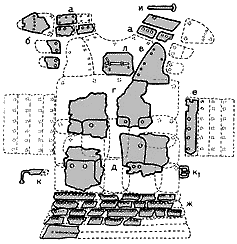 Rectangular plates (A) of 5 to 9 cm in length with iron rivets and decorative brass heads find analogues in artifacts from the upper Abakan. These plates may have been linked to details of the Tataro-Mongolian defense known as �reinforced Khatangu Deghel�, where metal plates were riveted or sewn to the underside of a soft leather or cloth base, the whole covered at the outside with elaborate cloth showing the rows of rivet heads.
Rectangular plates (A) of 5 to 9 cm in length with iron rivets and decorative brass heads find analogues in artifacts from the upper Abakan. These plates may have been linked to details of the Tataro-Mongolian defense known as �reinforced Khatangu Deghel�, where metal plates were riveted or sewn to the underside of a soft leather or cloth base, the whole covered at the outside with elaborate cloth showing the rows of rivet heads.
However, similar plates are also known from finds from Western Europe, where they are dated to the sixties of the 14th century. Moreover, the second set of plates do not allow this defense to be unequivocally identified as belonging to the set of Tataro-Mongol artifacts.
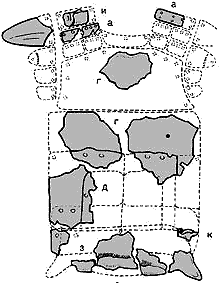 Plates of group (Б) of 5 to 11 cm in length, serving as edging over arm holes are known from finds in Northern Europe, dated to the XIV cent., as well as from Western European and Russian art of the same period. In Western Europe, these plates, being considered part of a �Byzantine� type armour, could well have been adopted from Byzantium or Russia.
Plates of group (Б) of 5 to 11 cm in length, serving as edging over arm holes are known from finds in Northern Europe, dated to the XIV cent., as well as from Western European and Russian art of the same period. In Western Europe, these plates, being considered part of a �Byzantine� type armour, could well have been adopted from Byzantium or Russia.
Very large rectangular plates of types (Г) and (Д) find direct paralels among finds and art illustrations of armour in Western Europe of the second quarter of the fourteenth century. The same may be said of the large rectangular plates of type (B), which protect the upper part of the chest, as well as the side plates (E).
Long narrow plates (Ж), with rivets along the upper (long) edge, protected the base of the �breast� part, as evident from Western European paralels of the second half of the fourteenth century.
The back of the cuirass ends in a long, comparatively wide plate (З) with a shaped lower edge � its corners go down and outward, while the edge of the mid-part curves outward and up. One of the cuirasses found at Wisby has an analogous base.
Fasteners, in the forms of bracket and pin (И), hook and loop (K), and buckles (K1) have analogues in the armours of mid fourteenth century Western Europe as well.
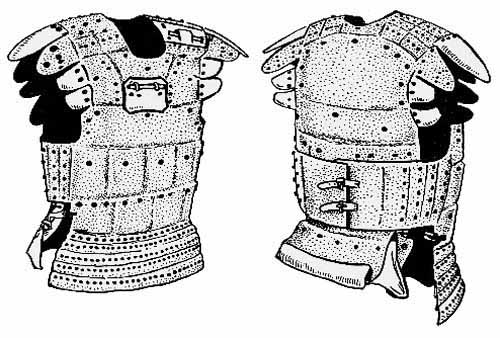
On the basis of all archeological and representational evidence the armour can be dated to the later sixties � early seventies on the fourteenth century.
The majority of known analogues to the armour under discussion belong to the North of Europe, and mainly Wisby, explained by the simple fact that the vast majority of known Western-European armours (Tran.: of the late 14th cent.) were part of that find. However, considering the place of the find under discussion, the origin of the Azov armour is most likely Italian.
Further, the Azov armour and those from Wisby have two substantive differences.
First, the analogous Gotland armours, in contrast to the Azov armour lack armouring of the back.
The second substantive difference is the existence on the Azov armour of a semi-rectangular plate (Л) with a side measure of 10.5 cm. Two loops welded to the plate retain a pin.
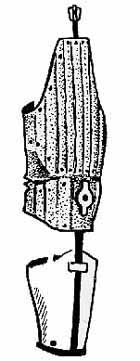 Judging from known analogues, this plate was used for fastening chains, which were in turn connected to the handle of a sword, a dagger, and a large �heraldic� helm.
Judging from known analogues, this plate was used for fastening chains, which were in turn connected to the handle of a sword, a dagger, and a large �heraldic� helm.
These distinctions indicate that the heavier Azov armour, connected with a �heraldic� helm, was most likely owned by a feudal lord � a knight.
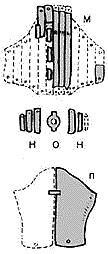 In addition to the torso defense, the finds also contained the remains of an armour for the leg, though it is not unlikely that this was for the arm, as the structure of such defenses was virtualy identical, the distinctions are solely noted due to size.
In addition to the torso defense, the finds also contained the remains of an armour for the leg, though it is not unlikely that this was for the arm, as the structure of such defenses was virtualy identical, the distinctions are solely noted due to size.
The surviving plates consist of a set of narrow, long plates (M) for the thigh (shoulder), narrow, short (H) plates and a round one (O) for the knee (or elbow) and a large, one-piece plate forming half of a shin (or forearm) defense.
Thus, in a Tatar home were found the defensive arms of a Western European knight, together with a set of horse furniture � a bit and bridle belt plaques, the date of which does not contradict the date of the armour � the late sixties or seventies of the fourteenth century. In the opinion of S. P. Karpov, such a set of arms is likely to have belonged to the head of one of the Italian colonies of Azak � either the Venetian or Genoese.
The original Russian article can be found at "Tozhe Gorod" ("Also City") (http://www.tgorod.go.ru), a resource of the reenactor community of the states of the Former Soviet Union.
|



 Judging from known analogues, this plate was used for fastening chains, which were in turn connected to the handle of a sword, a dagger, and a large �heraldic� helm.
Judging from known analogues, this plate was used for fastening chains, which were in turn connected to the handle of a sword, a dagger, and a large �heraldic� helm.
